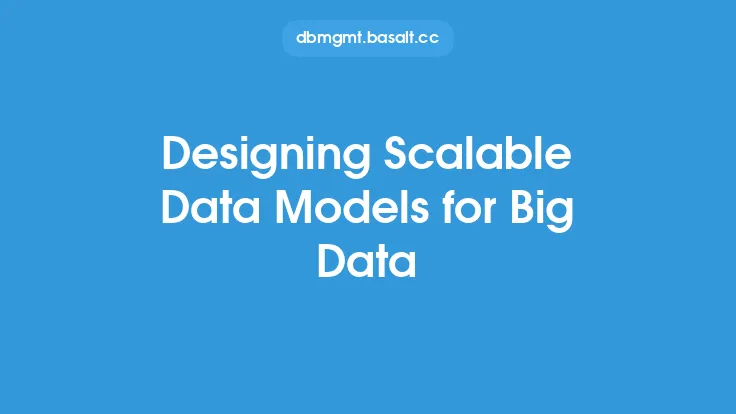Designing a data warehouse for big data analytics requires a thorough understanding of the underlying architecture, data models, and technologies involved. A data warehouse is a centralized repository that stores data from various sources in a single location, making it easier to access and analyze. The primary goal of a data warehouse is to provide a unified view of an organization's data, enabling business users to make informed decisions.
Introduction to Data Warehouse Architecture
A typical data warehouse architecture consists of several layers, including the source systems, data integration layer, data warehouse layer, and business intelligence layer. The source systems layer includes various data sources, such as relational databases, flat files, and external data providers. The data integration layer is responsible for extracting, transforming, and loading (ETL) data from the source systems into the data warehouse. The data warehouse layer stores the integrated data in a structured format, making it easier to query and analyze. The business intelligence layer provides tools and interfaces for business users to access and analyze the data.
Data Modeling for Big Data Analytics
Data modeling is a critical aspect of designing a data warehouse for big data analytics. A data model defines the structure and relationships of the data, making it easier to store, retrieve, and analyze. There are several data modeling techniques, including entity-relationship modeling, dimensional modeling, and object-oriented modeling. Dimensional modeling is a popular technique used in data warehousing, as it provides a simple and intuitive way to model data for analysis. A dimensional model consists of facts and dimensions, where facts represent measurable events, and dimensions provide context for the facts.
Data Warehouse Storage Options
There are several storage options available for a data warehouse, including relational databases, column-store databases, and NoSQL databases. Relational databases, such as Oracle and SQL Server, are traditional storage options for data warehouses. However, they can become bottlenecked as the volume of data increases. Column-store databases, such as Vertica and Sybase IQ, are optimized for analytics workloads and provide faster query performance. NoSQL databases, such as Hadoop and Cassandra, are designed for big data storage and provide a flexible schema-less data model.
Data Integration and ETL
Data integration and ETL are critical components of a data warehouse. ETL involves extracting data from source systems, transforming it into a standardized format, and loading it into the data warehouse. There are several ETL tools available, including Informatica, Talend, and Microsoft SQL Server Integration Services. These tools provide a graphical interface for designing and executing ETL workflows. Additionally, big data integration tools, such as Apache NiFi and Apache Beam, provide a scalable and flexible way to integrate data from various sources.
Big Data Analytics Technologies
Big data analytics technologies, such as Hadoop, Spark, and NoSQL databases, provide a scalable and flexible way to store and analyze large volumes of data. Hadoop is a popular big data platform that provides a distributed file system and a map-reduce programming model. Spark is an in-memory computing engine that provides faster performance than traditional map-reduce. NoSQL databases, such as MongoDB and Cassandra, provide a flexible schema-less data model and scalable storage.
Data Warehouse Security and Governance
Data warehouse security and governance are critical aspects of designing a data warehouse for big data analytics. Security involves protecting the data from unauthorized access, while governance involves managing the data and ensuring its quality and integrity. There are several security measures available, including authentication, authorization, and encryption. Governance involves establishing policies and procedures for data management, including data quality, data retention, and data archiving.
Data Warehouse Scalability and Performance
Data warehouse scalability and performance are critical aspects of designing a data warehouse for big data analytics. Scalability involves designing the data warehouse to handle increasing volumes of data, while performance involves optimizing the data warehouse for fast query execution. There are several techniques available for improving scalability and performance, including data partitioning, indexing, and caching. Additionally, big data technologies, such as Hadoop and Spark, provide a scalable and flexible way to store and analyze large volumes of data.
Conclusion
Designing a data warehouse for big data analytics requires a thorough understanding of the underlying architecture, data models, and technologies involved. A well-designed data warehouse provides a unified view of an organization's data, enabling business users to make informed decisions. By understanding the various components of a data warehouse, including data modeling, storage options, data integration, and big data analytics technologies, organizations can design a scalable and flexible data warehouse that meets their big data analytics needs. Additionally, by implementing proper security and governance measures, organizations can ensure the quality and integrity of their data, while improving scalability and performance.





